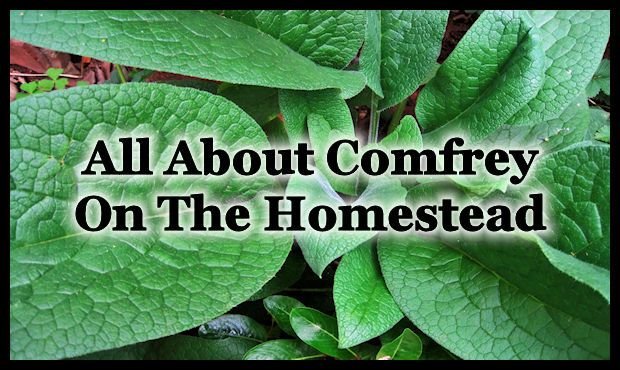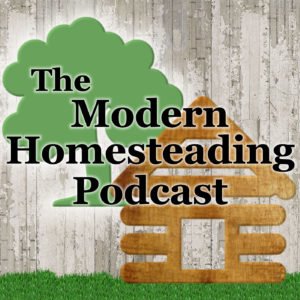All About Comfrey On The Homestead

On this episode of the Modern Homesteading Podcast I discuss the many uses of having comfrey on the homestead and why EVERY homesteader should probably be growing it, what variety to grow and where to get it.
Listen Here:
http://api.spreaker.com/download/episode/11920430/062_all_about_comfrey_on_the_homestead.mp3
“I say, if your knees aren’t green by the end of the day, you ought to seriously re-examine your life.”
~Bill Watterson, Calvin & Hobbes
My thoughts on this quote: If you want a better perspective on life try looking at it from ground level in your garden. When You work in your garden and look closely at the miraculous ecosystem active right in your backyard it will make you keenly aware that there is so much more going on the world than what you are normally aware of and help you to see things with a fresh set of eyes.
Praying Mantis and Ladybugs
Greenhouse update
New Fruit Trees
Urban farmer turns town garden plot into permaculture experience
Detroit Urban Farming Plan Shifts to Be More Neighborly
Main Topic Of Discussion:
All About Comfrey On The Homestead
What is Comfrey?
Comfrey is a perennial herb most commonly known for its qualities as a fertilizer and as herbal medicine. Comfrey is known as a dynamic accumulator because of its long tap root and ability to pull nutrients from deep in the soil up into its leaves.
Different varieties of comfrey
Common Comfrey – It is a perennial native to Europe. It is 3 feet tall including the flower stalk. It has been used medicinally for thousands of years by many different cultures. It can be somewhat invasive by spreading viable seeds. The roots are not invasive. True Comfrey seeds germinate quickly, especially on wet soil.
Russian Comfrey – a natural cross between common comfrey and rough comfrey. It grows to 4 feet tall including the flowerstalk. Russian comfrey has purple, white, magenta-pink, red or blue (that fade to pink) flowers. The seeds are not viable. It has to be reproduced by root and crown cuttings. It produces 100-120 tons per acre of biomass per year. This is 3 times the amount that Common Comfrey produces. There are 21 cultivars of Russian Comfrey but #4 and #14 are the most common.
Russian Comfrey Bocking 4 – More commonly used as fodder for feeding livestock. The roots of Bocking 4 go down 8-10 feet which makes is slightly more drought resistant and the leaves are slightly wider than bocking 14.
Russian Comfrey Bocking 14 – This cultivar is more commonly used as a fertilizer because of its more narrow leaves which break down slightly faster, although both 4 and 14 are very similar and can be used as both fodder and fertilizer. The roots of 14 go down 6-8 feet which is a little less than Bocking 4. Bocking #14 Comfrey is more rust resistant than #4. Rust is a fungal disease though disease is very rare in all comfrey. It has an NPK ratio of 1.8 / 0.5 /5.3 and dried comfrey leaves contain 26% protein. Also Comfrey is the only plant known to harvest vitamin B-12 from the soil.
Comfrey as fertilizer
Compost Activator – include comfrey in the compost heap to add nitrogen and help to heat the heap. Comfrey should not be added in quantity as it will quickly break down into a dark sludgy liquid that needs to be balanced with more fibrous, carbon-rich material.
Compost Tea – can be produced by rotting leaves down in rainwater for 4–5 weeks.
Chop and Drop – a layer of comfrey leaves placed around a crop will slowly break down and release plant nutrients but avoid using flowering stems as these can root.
Companion Planting – soil tests confirm that when comfrey is planted alongside other plants and especially other perennials and trees that soil nutrients increase.
Comfrey as livestock feed
Russian Comfreys can produce up to 100-120 tons per acre of leaf biomass per year. This is about 12.4 tons of dried comfrey leaf per acre. As a comparison Alfalfa yields 18 tons per acre. Corn is 25 tons per acre before it is dried. Pasture grass is 25 tons an acre.
The protein amount in dried comfrey is 20-30%. As a comparison most beans (legumes) are around 8-9%. Soybeans are around 17%.
Comfrey as medicine
External use as a Poultice, Oil or Salve:
Treats Skin Irritation
Can Treat Minor Cuts and Wounds
Speeds Healing Of Broken Bones
Warning: Don’t use comfrey on deep wounds as it can heal the skin to quickly aiding in possible infection.
Internal use:
Warning: In 2001, the United States Food and Drug Administration issued a ban of comfrey products marketed for internal use, and a warning label for those intended for external use. In addition to restrictions on oral use, some experts recommend applying comfrey extracts no longer than 10 days in a row, and no more than 4–6 weeks a year.
Can heal internal wounds in the digestive tract but with potential risks.
Comfrey as income
I added this as a quality of comfrey because I think it makes a great commercial crop for homesteaders, not necessarily as selling what the plant produces but selling crowns and root cuttings so other homesteaders can grow their own comfrey.
Where do I get comfrey? Marsh Creek Farmstead is where I purchased my crowns and root cuttings that I started with and I couldn’t be happier with them.
The Herbal Medicine-Maker's Handbook: A Home Manual
Youtube Channel - Morag Gamble : Our Permaculture Life
Show Notes For This Episode Can Be Found At: http://smalltownhomestead.com/62

G'day from a wanna be steader from Down Under! I'm new here and I've just found you and followed. Also purchased my first comfrey plant last weekend. What a great week! Looking forward to more great content from you in the future.
You're gonna love having comfrey on your homestead. I started with 3 and i kept splitting them up and in a couple years had 40 or so plants.
I hope so, it's taken me a couple of months to find some locally here. It's on the dangerous food list and people either don't realise it's miriad other uses or just don't want to sell it. But I have it now so I'm happy. Thanks for the reply. 🌿
Hi! I am a robot. I just upvoted you! I found similar content that readers might be interested in:
http://smalltownhomestead.com/all-about-comfrey-on-the-homestead-2/
Great post!
Thanks.
Nice post. Does that cheetah thing do that to you even if you are posting your own content from another site off Steemit? Wish I had some Comfrey here, much easier to replant than start from seed :/ But I agree, a must have in any homestead or farm. If you can grow it, Grow it :) @ecoknowme
Thanks. I have no idea about that cheetah thing but it's my post so it ain't like i'm stealing it, lol. Comfrey sure has made a huge difference on my homestead for sure.
meep
meep meep
meep